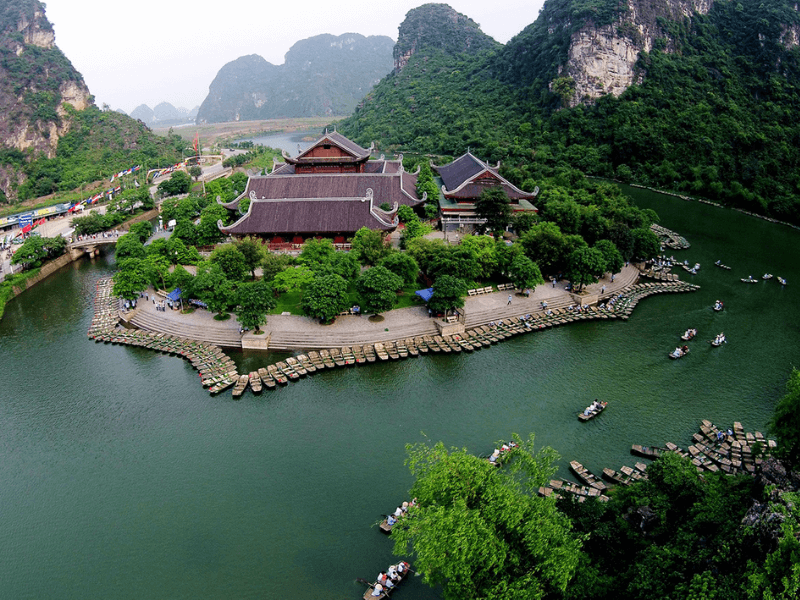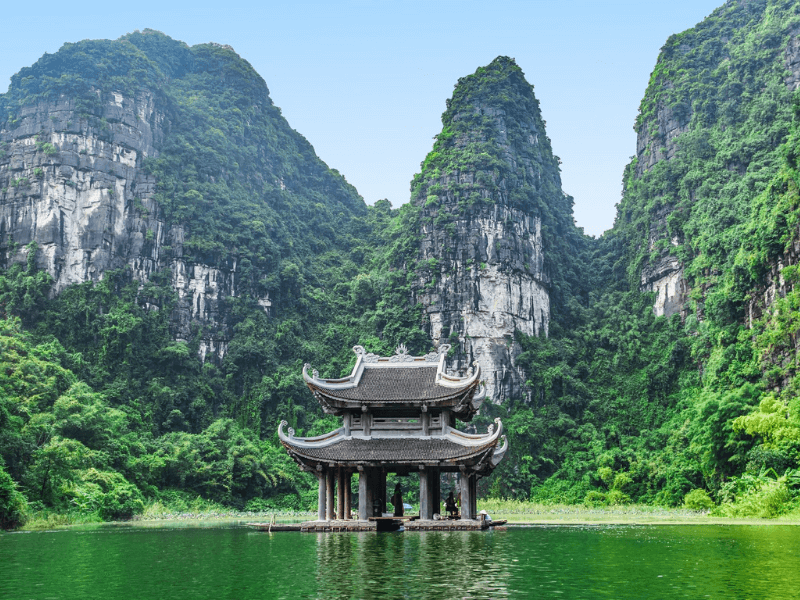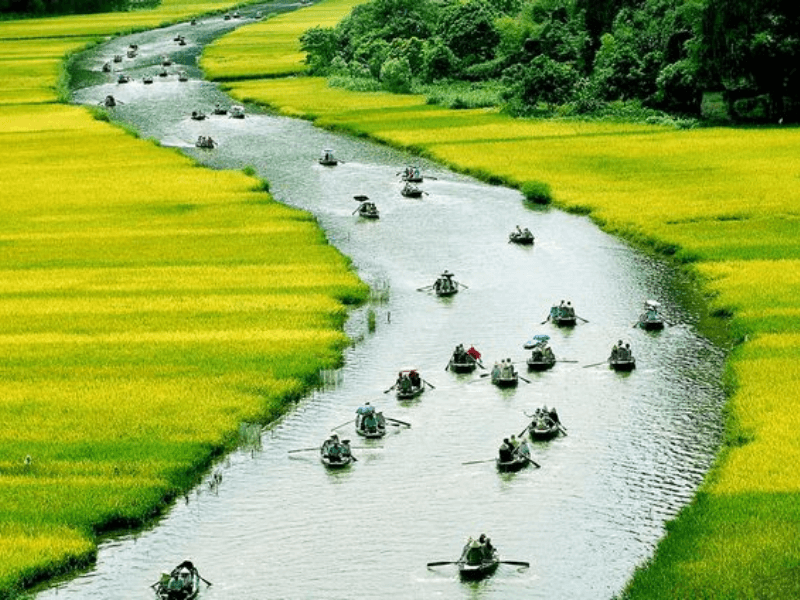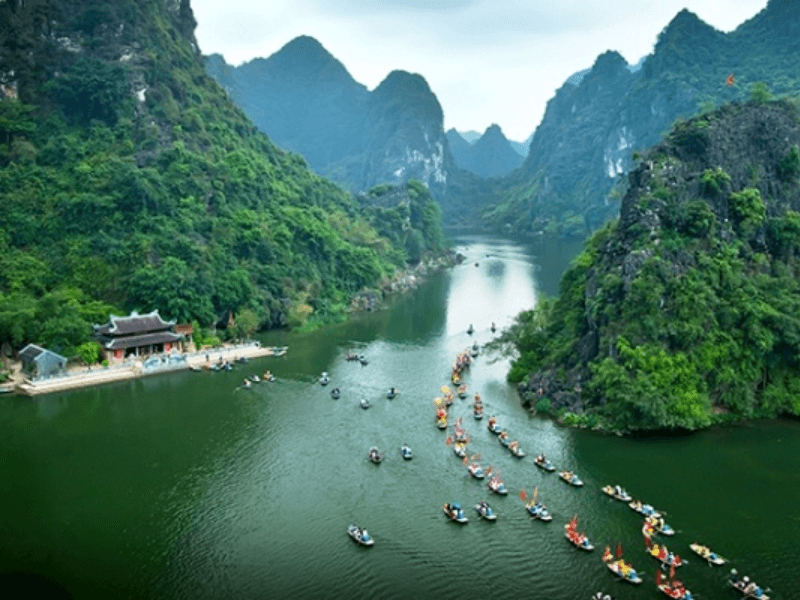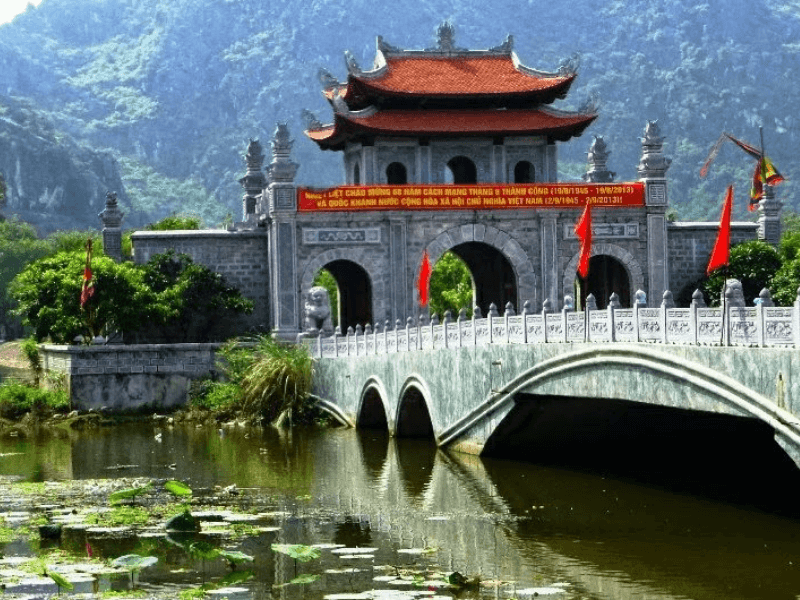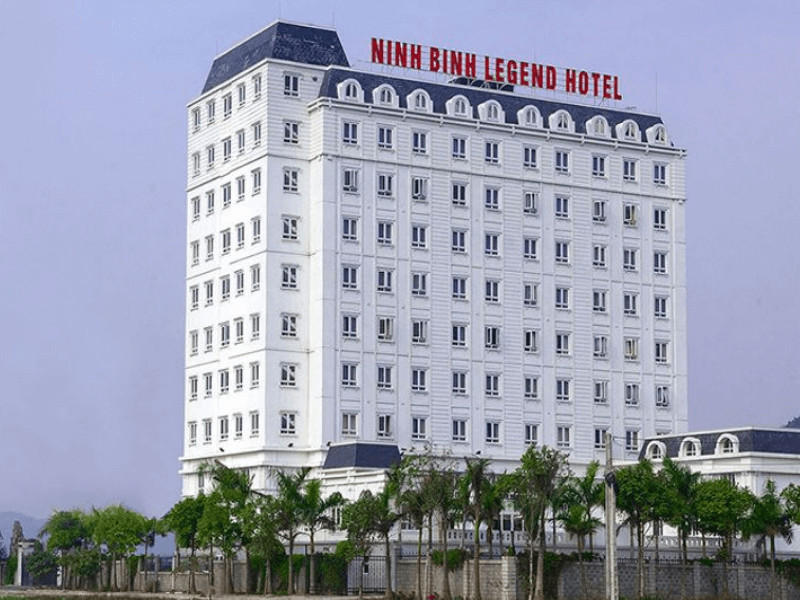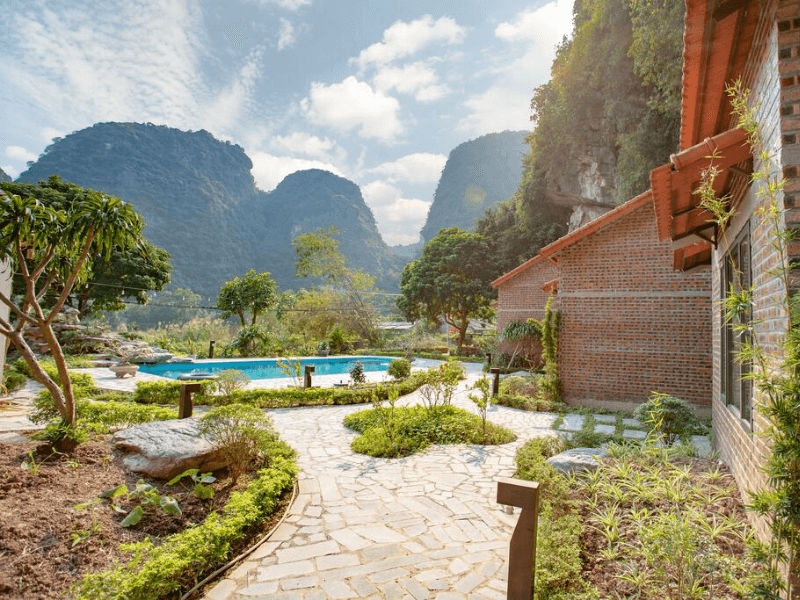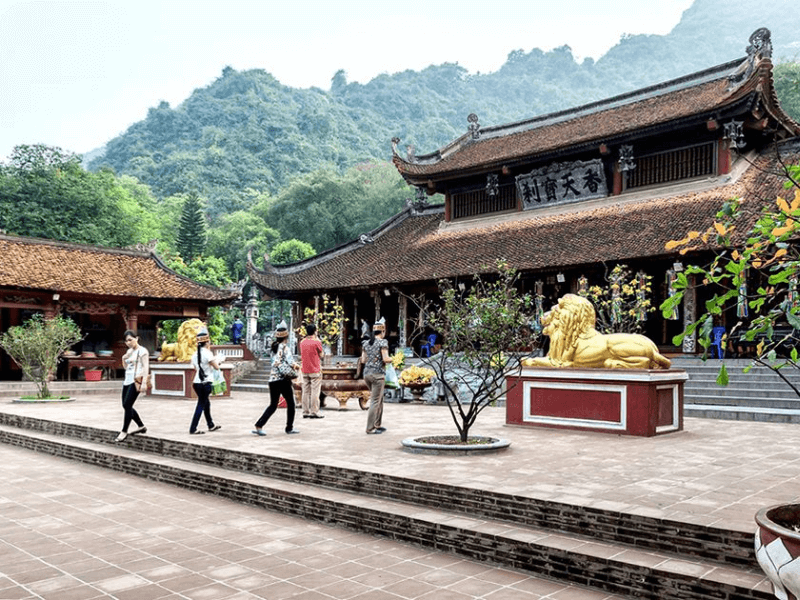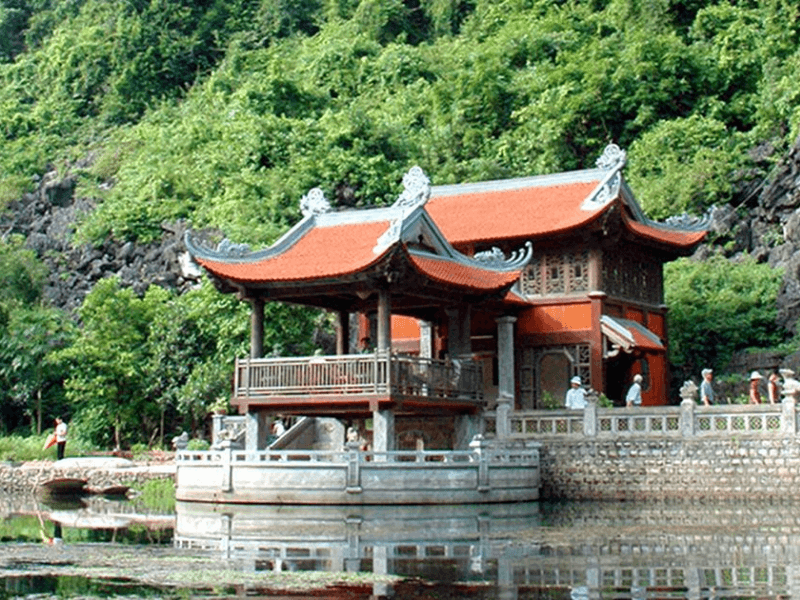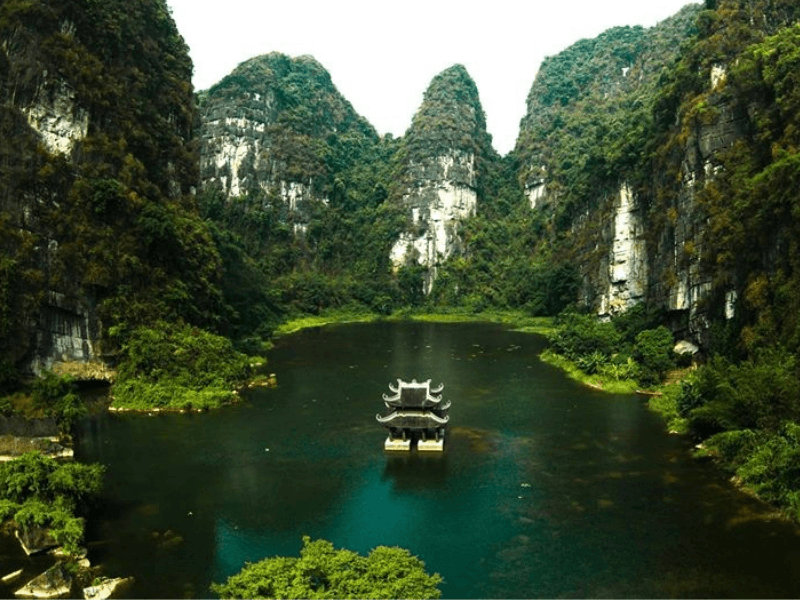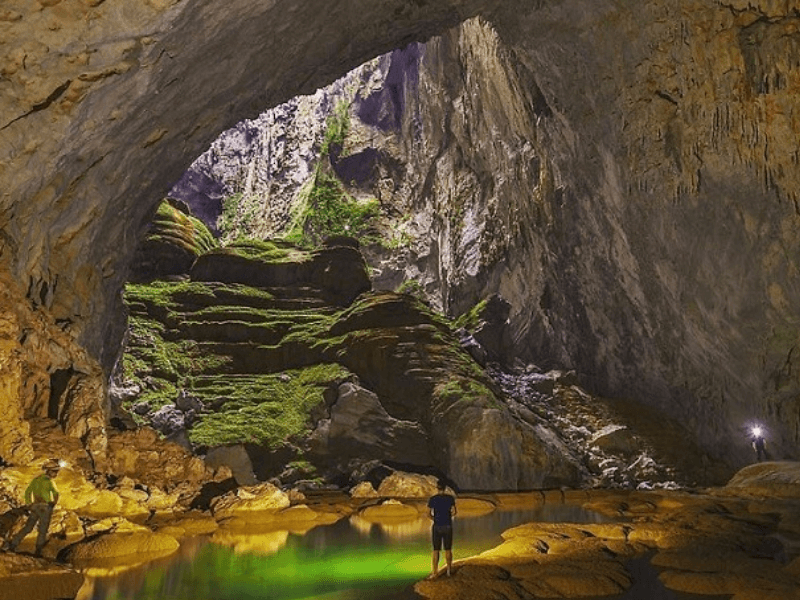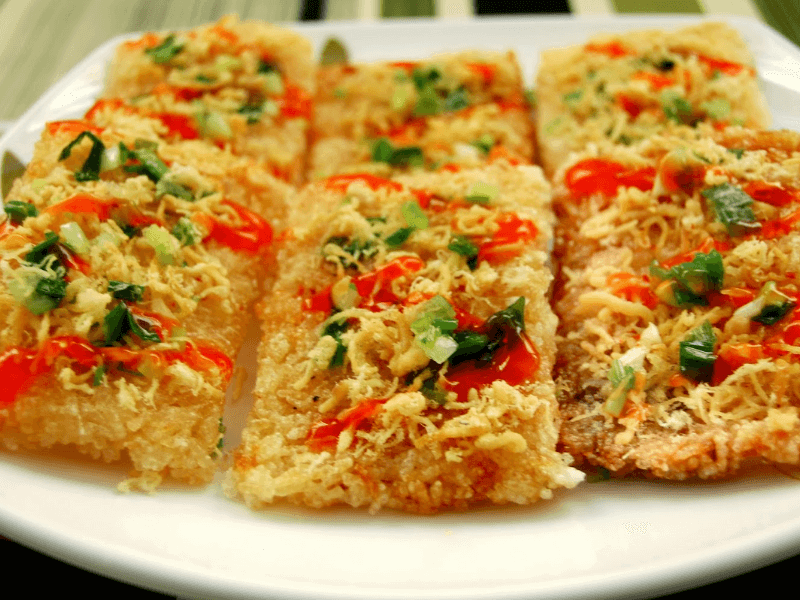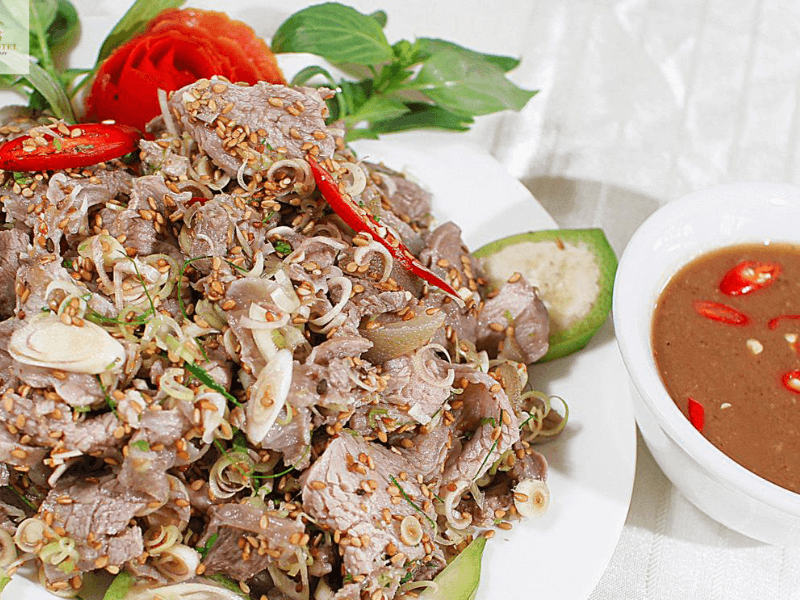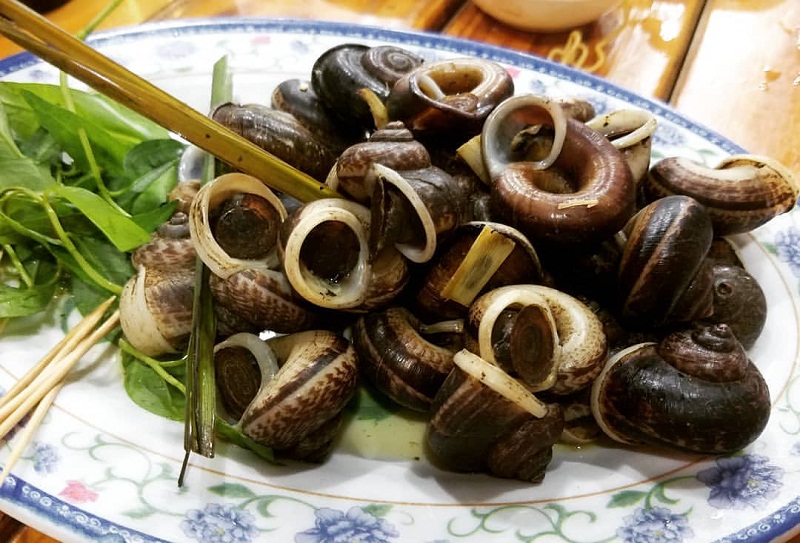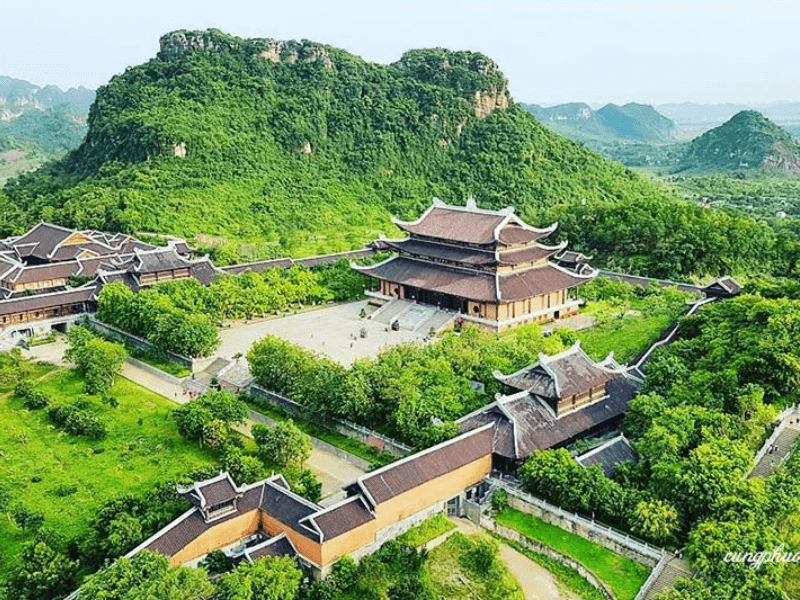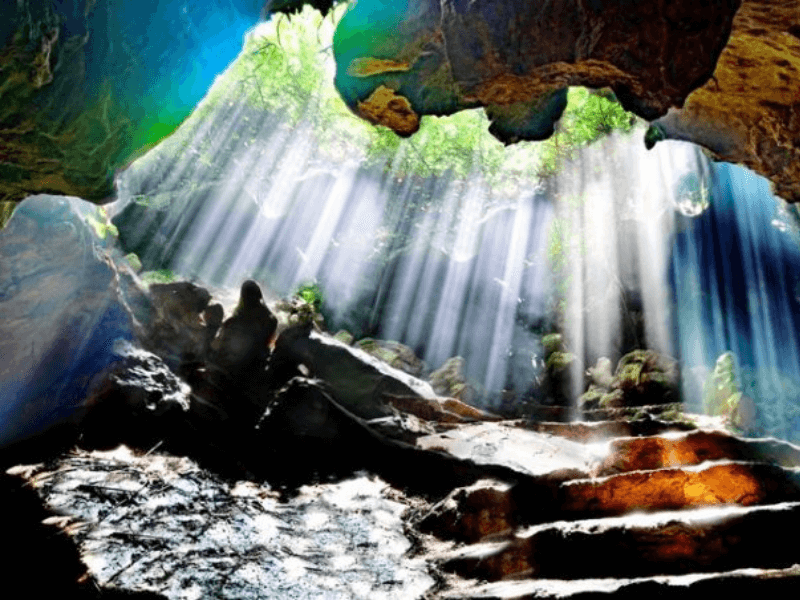Trang An Scenic Area covers an area of over 6,000 hectares and belongs to many communes and wards of Hoa Lu District, Gia Vien District, and Ninh Binh City. This is a place where visitors can enjoy the natural picture, indulge in people’s hearts, and have moments of tranquility and relaxation in a unique cultural and spiritual space. Considered a terrestrial Ha Long Bay, Trang An tourism attracts tourists through its diverse system of limestone mountains and natural caves. Here, you will be surprised by the system of nearly 50 trans-water caves connecting 31 flooded valleys like a strange and unpredictable map. What makes the attraction in the caves is the natural stalactite system with cool water flowing along the deep paths on the cave wall, forming winding currents.
Table of Contents
Introduction to Trang An – Ninh Binh
Trang An is an ecotourism area located in the World Heritage Site of Trang An in Ninh Binh Province. This place has been ranked by the Vietnamese Government as a special important national monument and recognized by UNESCO as a dual world heritage since 2014. Trang An with a system of limestone mountains with a geological age of about 250 million years, Over a long period of weathering by changes in the earth, climate, sea progress, and degraded sea, hundreds of valleys, caves, lakes, and lakes have been present.
This scenic spot is a place that preserves and contains many wetland forest ecosystems, karst forests, archaeological sites, and historical and cultural sites. The system of rocky mountains, rivers, streams, forests, and caves in Trang An is very dangerous, so King Dinh Tien Hoang chose to become the South to protect Hoa Lu’s capital in the 10th century and later used it as Vu Lam palace, during the Nguyen Mong resistance. Currently, there are many historical relics of the Dinh and Tran dynasties.
Where is it?
The complex of Trang An – Tam Coc – Bich Dong – Hoa Lu ancient capital – Hoa Lu special-use forest is now being generally planned into the Trang An scenic complex, becoming the first dual world heritage in Vietnam with outstanding value in the natural landscape, cultural history, and geological formations and is also a place invested to become a world-class tourist area.
The center of Trang An boat wharf is located 3 km south of Hoa Lu, 7 km west of Ninh Binh city, along Trang An Avenue, 16 km from Tam Diep city in the north through Tam Coc, away from Ha. Inner 96 km to the south. The Trang An – Tam Coc heritage core zone has an area of more than 6,172 hectares, and is a specially protected area of the scenic beauty spot. This special protection zone is located entirely in Hoa Lu’s special-use forest, belongs to Hoa Lu’s ancient capital conservation plan, and also belongs to the master plan of Trang An world heritage complex with an area of 12,252 ha.
In the complex of Trang An landscapes, the center of Hoa Lu’s ancient capital is in the north, the Tam Coc-Bich Dong tourist area is in the south and the Trang An eco-tourism area is at the center. These 3 areas are linked together by Hoa Lu’s special-use forest on limestone mountains and a system of rivers, lakes, and lagoons.
The history of Trang An – Ninh Binh
The prehistoric community of Trang An settled in caves or rocky roofs, distributed concentratedly in the limestone swamp valley, under the great impact of environmental landscape and environmental changes due to sea waves. regression sea. The prehistoric residents here were the first people to approach and exploit the sea in Vietnam, creating a combination of limestone labor tools, long-standing maintenance of the hewn industry, and the early generation of sawing techniques. grinding; pottery production and popular use. The prehistoric cultural and archaeological evidence in Trang An is plentiful and diversified, is a real material source demonstrating the special economic, cultural, and social changes of the population community here under the impacts of changing karst environment, changes in ancient climate, and sea level in monsoon tropics. These are the most typical evidence for this type of continuous cave residence before and after the sea.
The characteristic of the ancient Vietnamese in Trang An is the tradition of exploiting and using marine and terrestrial mollusks, the tradition of hunting diversified, in a broad spectrum, hunting many species, each species a little and not leading to the destruction that destroys that herd of animals. The tradition of crafting and using limestone tools, and the emergence of grinding, sawing, and pottery-making and farming techniques in the muddy valley are unique, making the pants stand out globally. archaeological relics here. It can be thought that the system of Trang An prehistoric archaeological sites still contains the monopoly or at least special evidence of the existing or lost cultural traditions or civilization of humanity.
The Legend of Hoa Lu Capital
Trang An is associated with the historical and cultural values of the ancient capital of Hoa Lu. In 968, Dinh Bo Linh unified Giang Son, founded Dai Co Viet state, and settled the capital in Hoa Lu. Hoa Lu capital city consists of 3 contiguous circles of the citadel: East, West, and South citadel. Thanh Dong is located in the east, bordering on the plains, where the palace is located, so it is called the suburban; The Western Citadel was located inside, bordered by the mountains, was the residence of mandarins and the logistics area should be called the inner city. The South Citadel was wider, a dangerous mountainous area to defend and protect the capital city now known as Trang An. With such a topographic feature, Hoa Lu’s capital city is compared to the stone capital with the following characteristics: mountains are cities, rivers are roads, and caves are palaces.
Legend has it that King Dinh Tien Hoang wanted to affirm that the Hoa Lu capital was as superficial as the northern capital of Trang An, so he ordered Nguyen Bac to express the sentence “Co Viet Quoc, Tong Khai Bao – Hoa Lu, Han Trang An Urban”. In 1010, King Ly Thai To changed Hoa Lu to Trang An and Dai La to Thang Long. The title Trang An is officially associated with the ancient capital of Hoa Lu – Ninh Binh. Currently, Trang An belongs to the specially protected area of the ancient capital Hoa Lu, This area has been recognized by UNESCO as the core zone of the world’s natural cultural heritage of Trang An.
When should go to Trang An?
Usually, the best time to go to Trang An is at the beginning of the year from March to March, the weather is cool, not too hot. This is also the festive season at Bai Dinh Pagoda, so it is possible to combine spring travel and the pagoda landscape. However, going into this season has a disadvantage in that tourists are very crowded and sometimes have to wait a long time to get a boat. Besides, you can refer to a few more periods as below to combine Trang An tourism and tourist destinations around it.
- The traditional festival of Hoa Lu ancient capital (also known as the Truong Yen festival or Co Lau festival) takes place on March 8-10 of the lunar calendar every year.
- The end of May and early June is Ninh Binh.
How to go to Trang An
Going to Ninh Binh
By road
Ninh Binh is an important intersection point. The most advantageous thing to come to Ninh Binh is through the road traffic system.
Bus routes to Ninh Binh from Hanoi all start from Giap Bat bus station and end at Ninh Binh Central bus station. Because Ninh Binh City is also located right on the NH1A axis. In addition to these routes, you can use any other route from Hanoi to the central or southern provinces (choose bus routes from Hanoi). Thanh Hoa, Vinh, Ha Tinh … because these routes are a lot and run quite continuously).
If you use the car, from Hanoi you can follow the Phap Van – Cau Gie – Ninh Binh highway, with a distance of about 90km, it only takes about 1 hour, and you will reach the center of Ninh Binh City from here, going to tourist destinations in the province is almost no more than 30km.
If you use a motorbike vehicle, from Hanoi you follow the old QL1A road through Ha Nam and then go towards Ninh Binh Thanh Hoa. Note that you should not go wrong in the direction of Nam Dinh – Thai Binh to help the roundabout.
By rail
Ninh Binh has the urban axis of Tam Diep – Ninh Binh located on the North-South railway line. In the province, there are Ninh Binh, Cau Yen, Ghenh, and Dong Giao stations. Therefore, whether in the South or outside the North, you can easily come to Ninh Binh by Thong Nhat train.
From Hanoi, there are SE1 trains (19:30) to Ninh Binh at 9:46, SE3 train (22:00) to Ninh Binh at 00:10, train SE5 (9:00) to Ninh Binh at 11:21, train SE7 (6:00) to Ninh Binh at 8:22
If departing from Saigon, all trains arrive at Ninh Binh at most late hours, The only suitable train that you should go to is SE8 departing from Saigon station at 6:00 am and arriving in Ninh Binh at 13:15 the next day.
Find ways to travel to Ninh Binh here
From Ninh Binh to Trang An
Trang An is only about 7km from Ninh Binh city center (about 7km from Ninh Binh bus station, 8km from Ninh Binh station), quite close so you can rent a motorbike in Ninh Binh if you want to go yourself, otherwise, go motorbike taxi or taxi. For those of you traveling by private vehicle from Hanoi, when starting to the center of Ninh Binh city, you should notice that on the right-hand side, there is Trang An street, turn in and go straight for a few kilometers.
Going back to Trang An
The only means of transport in Trang An is a boat, and of course, you cannot bring a boat to paddle by yourself. When you enter the gate, you buy a ticket to include the boat in it. A boat carries 6 people, and definitely has to be enough 6 people to go. If in any case, you want to take a private boat, you just need to buy all 6 tickets. Previously there was only one route here, but after filming the movie Kong, a second itinerary has been added for visitors to choose from.
Route 1: Boat Station – Trinh Temple – Dark Cave – Morning Cave – Wine Cave – Tran Temple – Ba Giot Cave – Hang Seo – Son Duong Cave – Phu Khong – Bao Hieu Pagoda – Hang Khong – Hang Tran – Hang Quy Hau – Back to boat station (duration 3.5 hours)
Route 2: Boat Station – Hang Lam – Hang Vang – Hang Thanh Slide – Suoi Tien Temple – Hang Dai – Vu Lam Palace – Kong Films (Aboriginal Village) – Return to the marina (2.5 hours)
Route 3: Boat Station – Temple of Process – Hang May – Suoi Tien – Hang Dia Linh – Hang Dai – Hanh Cung Vu Lam – film studio Kong (Aboriginal village) – return to the marina (3 hours)
Where to stay in Trang An
In Ninh Binh City
Only about 7km from the city center, you should choose to stay in Ninh Binh city to have more choices in finding suitable hotels and motels. From here, it only takes about 15-20 minutes to go to Trang An boat station, so it is not too inconvenient.
Homestay in Trang An
If you do not like to travel far and want to enjoy life among the four beautiful natures, you can consider choosing to stay in several homestays near Trang An, but there are not too many options to choose from. you can decide.
Tourist site Trang An
Cultural relics
Trinh Temple
Trinh Temple is the place of worship for the 4 Dinh Dynasties, 2 Ta Thanh Tru, and 2 Huu Thanh Tru. In their reign, they were the General Supervisor of the Army, governing the king’s gold and silver treasury. Legend has it that when King Dinh Tien Hoang died, the court was in turmoil, they brought Dinh Toan here to avoid the arrest of Le Hoan. When Empress Dowager Duong Van Nga handed over the helmet to surrender the throne to the Ten Commanders General Le Hoan, the men did not submit to and martyred in this area, the people built the Palace on the side of the mountain to worship them.
Tu Tru Temple
Tu Tru Temple is located next to Trinh Temple, which is a relic of the four Dinh dynasties, including Prime Minister Nguyen Bac, Foreign Borders Dinh Dien, Thai Su Luu Co, and Senior Lieutenant Trinh Tu.
The book Dai Nam Quoc History of Theater and Folk Poetry often refers to the Four Pillars of “Bặc, Điền, Cơ, Tú”, ie the four pillars of the Dinh dynasty. The four pillars are four close officials, from the same hometown and the same age as Dinh Tien Hoang De, who helped King Dinh to quash the 12 warlords and reunify the country. The great gods Nguyen Bac, Dinh Dien, Trinh Tu, and Luu Co are now worshiped in many places, especially in the region of Ha Nam – Nam Dinh – Ninh Binh.
Tran Ninh Binh Temple
Tran Ninh Binh Temple was built by King Dinh Tien Hoang at the same time as Hung Temple. Later, King Tran Thai Tong came here to establish Vu Lam palace to continue improving his superficial position, so it was called Tran Temple. Tran Temple is the place to worship Quy Minh, the god of town in the south of Hoa Lu town. The temple is also known as Noi Lam temple (temple in the forest). Tran Noi Lam Temple together with Vu Lam and Van Lam formed Tam Lam under the Tran dynasty.
Phu Khong
Phu Khong lies on a narrow strip of land, his back leaning against the Khong cave, on the right is a steep rocky mountain range, and in front of it is a vast valley of water. Phu Khong is a place of worship for 7 lieutenants of the Dinh dynasty, associated with legends when King Dinh Tien Hoang died, 7 officials in the court brought many coffins to bury in all directions and then committed suicide to keep secrets. about the real tomb. A male guarding general was extremely grateful to the charisma of the 7 lieutenant gods and immediately set up a bowl of incense to worship here. After this general died, people in the area set up a temple and planted a tree in front of the palace to commemorate the gods. The thousand-year-old tree has two types of fruit: 1 round and 1 flat.
The Palace of Vu Lam
Vu Lam Palace is located deep in the mountainous areas of the World Heritage Site of Trang An. Vu Lam Palace Center worships the king of the Tran dynasty. During the Tran dynasty, there was the name Truong Han Sieu, his original father was Ninh Binh, a famous painter in the Tran dynasty, and an effective disciple of Tran Hung Dao. Truong Han Sieu is stubborn, educated, and has great merit in the second and third resistance wars against Yuan Mong. During the period when King Tran Nhan Tong returned to this land to practice, the god Truong Han Sieu also retreated to retreat and set up a practice house in Ninh Binh’s hometown. That is why Truong Han Sieu is also worshiped at this relic.
Cao Son Temple
Cao Son Temple worships Cao Son in Tay Hoa Lu town. According to the genealogical god of Cao Son temples in Ninh Binh, Cao Son, the great king is Lac General Vu Lam (i.e. the mountainous area west of Ninh Binh today, so it is also known as the western god of Hoa Lu town), the 17th child. King Lac Long Quan, when obeying his king (the first Hung Vuong) patrolling from Nam Linh to Thien Duong, found a type of tree with flour used as a cake instead of rice flour, named after his name for tree. is Quang lang (local people still call it Quang lang or fuzzing tree). God taught and helped people to do business and protected them from destructive forces, so the people established many temples.
Suoi Tien Temple
Suoi Tien Temple is located upstream of the Ngo Dong River, essentially an extension of the Tam Coc tourist route but connected to the second tourist line in the Trang An eco-tourism area. To worship Quy Minh, Nam town – Hoa Lu town.
Typical caves in Trang An
Hang Dia Linh
Dia Linh Cave is about 1500m long and is the first cave in the journey starting from Sao Khe riverboat station to visit line 1. The cave is also called Chau Bau Cave because when you come here you will feel lost. a treasure trove of fossil stalactites. Out of the mouth of the cave is a charming landscape of clouds, mountains, and rivers. The 260 m long cave with many miraculous drooping stalactites.
Wine Cave
There is an underground water circuit more than 10m deep in the cave. Legend has it that in the past, the seniors came here to get water to cook wine for the king.
Ba Giot Cave
Ba Giot Cave has many stalactites with various colors appearing. There is a type called hibiscus that grows from the ceiling upside down. The special point is that the stalactites in Ba Giot cave are not as dry as the previous ones, but are wet and continue to transform, forming new shapes and shades …
Hang Sinh, Hang Si, and Hang Ba Giot are associated with the legend of a sad love story. Once there was a guy who loved a princess dearly. When he came to Sinh cave to propose, she was paid tribute to the neighboring country. He went to Ba cave, bathed and washed, then embraced his love in Si cave.
Legend has it that those who pass through Ba Giot cave and receive three drops of water from stalactites in the palm of their hand will be lucky in life and happy in love.
Hang Boi
Hang Boi is a valuable archaeological site in the World Heritage complex of Trang An. The entrance to the cave is deep and dense with many species of trees growing thick, The sunlight cannot reach the ground, so the road is full of moss and a carpet of leaves.
Boi Cave was discovered in 2002. At that time, the cave had many mollusk shells, animal bones, and a few pieces of stripe, evidence shows that the prehistoric mark of early Hoa Binh culture was about ten thousand years ago. Researchers unanimously agreed to name the Boi cave because it was in the Boi Valley, associated with the legend of King mandarins of the Tran Dynasty who used to sow fortune-telling here.
What to eat when traveling to Trang An
Ninh Binh Burned rice
The scorched rice dish is not a traditional dish of Ninh Binh people, but was created by a son of the ancient capital and has been preserved and developed up to now. A rustic dish, showing the ingenuity of human hands, has been handed down for hundreds of years, becoming a specialty of the ancient capital, one of the famous delicacies of Ninh Binh.
Ninh Binh mountain goat meat
Ninh Binh mountain goat meat is characterized by a firm, low-fat, and fragrant flavor. It is said that this is because there are many rocky mountains and goats in Ninh Binh, so their muscles are firm and less fat than goats grazing on the hill. On the other hand, with the typical topography of submerged limestone mountains, there are many types of vegetables, grass, and herbs suitable for goat food such as sausages, yellow rolls, walkers, oxen, limbs, ox nails, gourd, gourd, carpentry, rat muzzle, oval parachute, tomato thorns, create the quality and delicious taste of goat meat. Some other local ingredients and specialties also contribute to the highlight of Ninh Binh goat meat dishes, including vegetables served with typical rocky terrain, Kim Son wine, Nho Quan Can wine, and Ninh Binh burned rice.
Ninh Binh mountain snail
This Ninh Binh mountain snail species is extremely rare because they only live in caves, it is not until the rainy season from April to August that the snails crawl in search of food and reproduce. Mountain snails are found in most places in Ninh Binh province but are concentrated in limestone mountains such as Tam Diep, Yen Mo, Nho Quan, and Hoa Lu. Mountain snails are difficult to detect, people often have to get up early in the morning when the snails crawl out of the cave to find food to find them. Mountain snail meat is chewy, crunchy, sweet, and fragrant with traditional herbs. Mountain snails can be processed into many dishes such as grilled, fried tamarind, steamed ginger, boiled with lemongrass, and mixed with onion salad … are very attractive.
Tong Truong perch
Tong Truong perch is a type of perch living in a submerged cave environment in Hoa Lu, Ninh Binh. It is called the Tong Truong perch because this fish was discovered in the flooded cave area of Truong Yen, now the world heritage complex of Trang An in Hoa Lu district. Tong Truong perch has solid meat, yellow, and fragrant, and can be processed into many dishes such as roasted, fried, cooked perch sour soup, or dried warehouse.
Some tourist schedules of Trang An
Synthesize some Trang An travel itineraries in combination with tourist destinations in the same complex as Bai Dinh, Hoa Lu, and Tam Coc Bich Dong for your reference. Depending on your actual timing, you can add or shorten the number of days to match.
Tour 1: Hanoi – Trang An – Bai Dinh – Hoa Lu (1 day)
Morning departure from Hanoi to Ninh Binh, If you follow the highway, it only takes more than 1 hour to be in Ninh Binh City. From here, we started going to Trang An tourist area.
Around 9 a.m., you will start exploring Trang An by boat, Depending on the schedule, it takes you about 2-3 hours to explore all of this place. After leaving Trang An, we went to Hoa Lu’s ancient capital relic, visiting the temple area of Dinh and Le Kings. Lunch break at a certain restaurant.
Afternoon visit Bai Dinh Pagoda, this is a very famous temple complex in Vietnam with many confirmed records. Finish your journey back to Hanoi.
Tour 2: Hanoi – Phat Diem Church – Trang An – Bai Dinh (2 days 1 night)
Day 1: Hanoi – Ninh Binh – Phat Diem – Thien Ha Cave
From Hanoi, we will go straight to Phat Diem stone church. This is a Catholic church complex with unique and unique architecture, built mainly of stone and wood for a long time from 1875 to 1899.
Rest for lunch. Afternoon from Phat Diem to visit Thien Ha Cave. Although the cave is not large, it is located in the mountain range of General, which is a part of the solid natural wall that protects the Hoa Lu capital in the 10th century. Thien Ha cave is visited by many tourists to understand more about the ancient capital.
Afternoon back in Ninh Binh City, rent a hotel in Ninh Binh City to rest, and remember to enjoy the specialties of Ninh Binh
Day 2: Trang An – Hoa Lu – Bai Dinh – Hanoi
From Ninh Binh City, move to the Trang An tourist area, and choose one of two routes to explore Trang An. After finishing the journey here, continue to the ancient capital Hoa Lu to visit the temple of King Dinh and King Le
Before returning to Hanoi, remember to visit Bai Dinh Pagoda, a new temple built with many Vietnamese records.
Tour 3: Hanoi – Cuc Phuong – Bai Dinh – Trang An – Van Long (3 days 2 nights)
Day 1: Hanoi – Ninh Binh – Cuc Phuong
Morning departure from Hanoi, about 3 hours will go down to the gate of Cuc Phuong National Park, and have lunch at Cuc Phuong. Visiting Cuc Phuong forest, Cay Tro thousand years old, places along the way from the forest gate to inside.
One night sleep in Cuc Phuong
Day 2: Cuc Phuong – Bai Dinh – Hoa Lu – Trang An
In the morning, check out, have breakfast, and then depart from Cuc Phuong to go to Bai Dinh pagoda, the largest and most majestic temple. From Bai Dinh continue to move to the ancient capital of Hoa Lu. After visiting the temples of King Dinh and King Le and discovering the ancient capital, you will have a rest for lunch and then continue to move to Trang An tourist area. Choose one of 2 moving routes here, return to Ninh Binh, Break Ngoi City, or have dinner and overnight in Ninh Binh City.
Day 3: Ninh Binh – Van Long – Kenh Ga – Hanoi
In the morning, check out, from Ninh Binh city to Van Long lagoon. This is also one of the places where Kong: Skull Island was filmed. Lunch from Van Long straight to Kenh Ga hot spring area, eating, resting, and hot spring bath.
Related Article: Traveling experience in Ban Gioc Waterfall that tourist should know
Let’s start your trip to Trang An – Ninh Binh with us! If you have any feedback or need help, please send an email to vietnamreviewer.contact@gmail.com!
Noted: All information and pictures are collected from the Internet!

